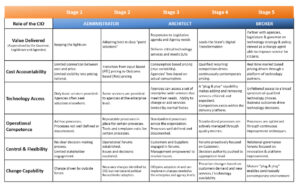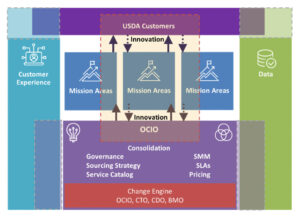Developing a Future State IT Service Delivery Platform
for USDA OCIO
Aminad Consulting helped the USDA Office of Chief Information Officer (OCIO) develop a future state service delivery platform that is customer-focused, data-driven, inclusive, and adaptable. Aminad utilized a leading services delivery framework to measure OCIO’s current state maturity as an organization, which led to a future state model and tangible recommendations in the areas of communication, customer experience, service delivery optimization, transparency, and innovation. With Aminad’s help, OCIO has a future state vision that is designed to change culture, sustain the culture changes over time, and move towards a customer first, continuously contemporary focus.
OCIO provides a wide array of end-user, desktop, infrastructure, security, and data analytics services as a shared services provider to USDA’s Mission Area customers. Beginning under the administration of former Secretary Perdue, USDA IT underwent significant disruption over the past several years that led to substantial changes (e.g., consolidation of IT services, restructuring of agencies into Mission Areas), new initiatives (e.g., leading IT modernization through Centers of Excellence, emphasis on innovation in IT), and an increased focus on customer experience. Although the disruption was positive, the changes were rapid and contained several new disparate outputs. Without effectively integrating and implementing the various outputs into a “platform,” OCIO struggled to improve IT service delivery to its customers.
Faced with the challenge of putting these pieces together, OCIO leadership – the CIO, Deputy CIO, and Chief of Staff – turned to an expert consulting team, including Aminad, to develop a cohesive and clearly stated vision of a mature, integrated service delivery operating platform. It also had to be one that could sustain recent leadership-driven initiatives while implementing the management practices that would preserve the benefits of consolidation.

Figure 1. Service Delivery Maturity Framework
- Clarity on Role and Vision was required – OCIO stakeholders lacked a clear statement about OCIO’s role and vision and how that role differed at the enterprise and Mission Area levels.
- Focus on Sustainability of Change was missing – Sustainability and change capability were not concepts embraced by OCIO stakeholders. Both OCIO and OCIO customers did not believe that changes and innovation would “stick.”
- No Consistent Services Management Practices – Elements of operational competence existed but did not fit together to create a consistent set of management practices across OCIO.
- Lack of Best Practice Shared Services Adoption – There was a hesitancy to embrace modern best practices for shared services organizations such as a Service Management Manual (SMM), a Configuration Management Database (CMDB), and contracts that enable integration across sources of supply.
The Aminad team facilitated a cross-functional working group that included stakeholders from both OCIO and Mission Areas to review these key findings and identify the foundational elements of a customer-focused, data-driven, and adaptable future state model necessary to gradually move up the service delivery maturity curve. The following foundational elements were built into the future state platform model depicted in Figure 2:

Figure 2. OCIO Service Delivery Future State Platform
- Clear, consistent, and unified communications and engagement from OCIO.
- Use of data to measure and communicate service delivery performance and improvement.
- Transparency, delivery, and agility as guiding principles.
- Alignment of delivery and customer facing processes with best practices for a multi-supplier services delivery environment.
- Communities of Practice – Launching of four cross-functional Communities of Practice (COPs) responsible for driving implementation – Cultural Change Engine, Customer Experience, Consolidation Sustainment, and Innovation.
- OCIO Communications Renewal Program – Development of a program focused on restructuring OCIO communications with a renewed emphasis on cultural changes and organizational maturity.
- Service Delivery Optimization Program – Development of a program focused on defining the elements of a managed services organization necessary to mature customer service, improve management of a multi-supplier model, and accelerate the ability to integrate services across sources of supply.
- OCIO Customer Experience and Transparency Program – Development of a program focused on bringing OCIO closer to its customers through renewed transparency of total costs and sourcing strategies.
The Aminad team next developed a comprehensive set of recommendations and an implementation roadmap to help OCIO build towards the future state. These recommendations were designed to ensure that OCIO would be able to create and sustain a culture of change through buy-in, collaboration, and expertise. Recommendations included:
- “Mission Area First” Innovation Program – Development of an innovation framework that focuses on fostering innovation at the Mission Area level as they are closer to USDA customers.
Aminad’s Unique Value to USDA OCIO
Aminad’s subject matter expertise helped quickly identify service delivery challenges
Facilitating collaboration within OCIO and across Mission Areas helped ensure buy-in on the proposed future state model
Practical and actionable recommendations and a roadmap that can lead to real success
After getting buy-in from OCIO and Mission Area IT leadership on the future state platform model and recommendations, the Aminad team helped OCIO kick off and manage implementation by standing up the COPs and organizing implementation activities. With our support, the program was able to successfully identify a future state vision, create buy-in from stakeholders from the Secretary on down, begin to sustain culture changes, and establish a foundation for future implementation activities through stakeholder engagement.

